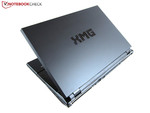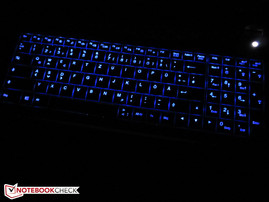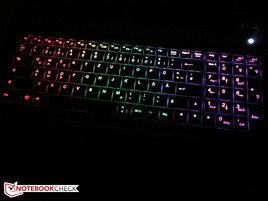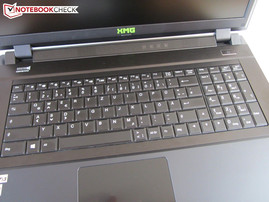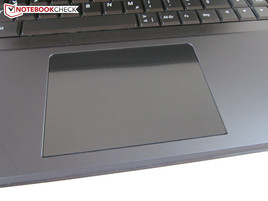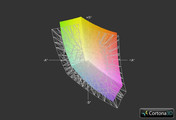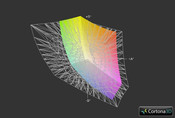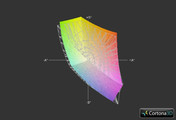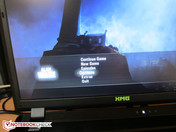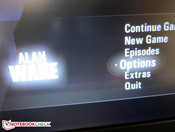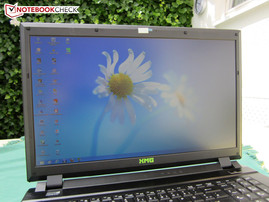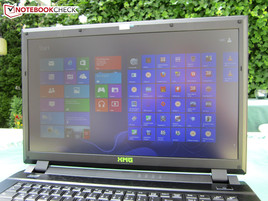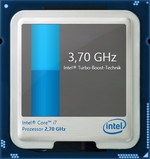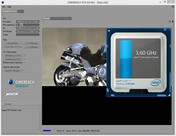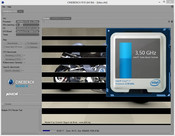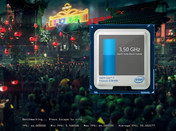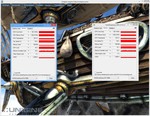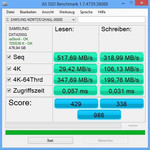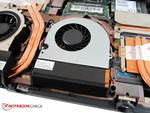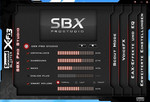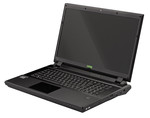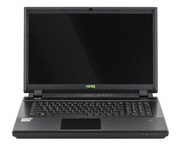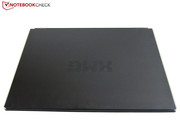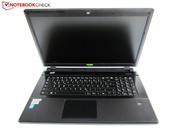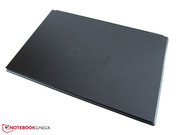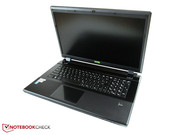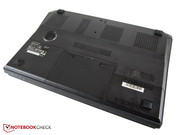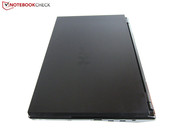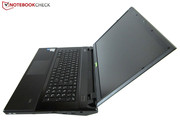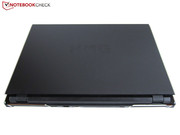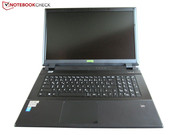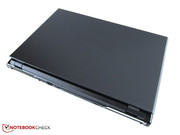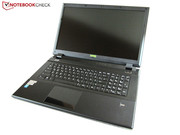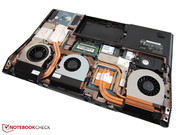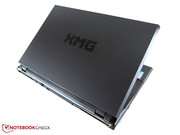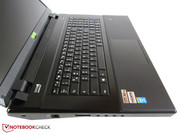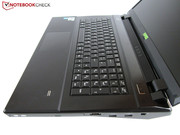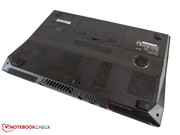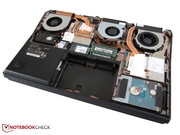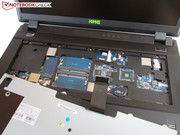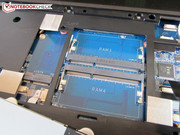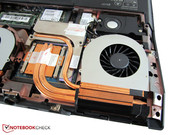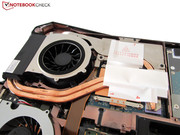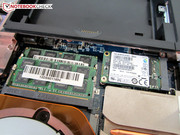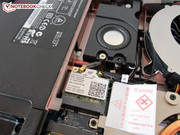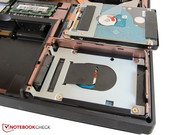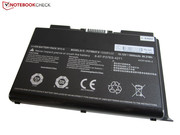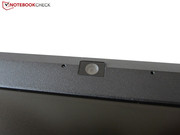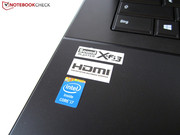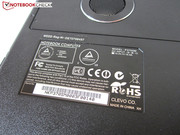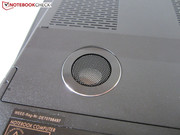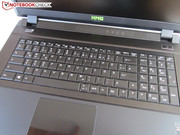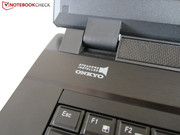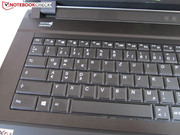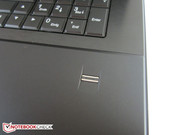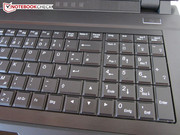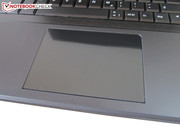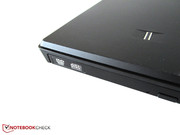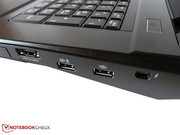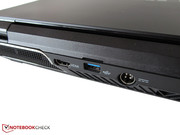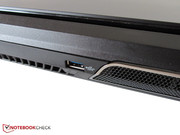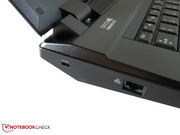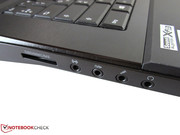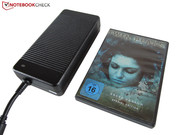Review Schenker XMG P723 (Clevo P370SM) Notebook
For the original German review, see here.
Unlike Asus, Toshiba, or Gigabyte, Schenker Technologies lets the customer be part of the notebook configuration process: the homepage (mysn.de) offers a variety of different components, which allows customers to spec out a system according to their individual wants and needs.
The XMG P723 features a staggering array of options. The customer can select either a glossy or a matte display with a resolution of 1920x1080 pixels (we recommend the non-glare panel) and various quad-core processors from Intel's Haswell generation. In addition to the Core i7-4700MQ, Core i7-4800MQ, and Core i7-4900MQ (all have a TDP of 47 Watts), Schenker also offers the more frugal Core i7-4702MQ (TDP 37 Watts) and the outrageously expensive Core i7-4930MX (TDP 57 Watts). Since the processor is hardly ever a limiting factor, one of the lower-end CPUs is usually sufficient - regardless of the graphics card.
Speaking of the GPU: depending on the configuration, the system houses either a single GeForce GTX 780M or two GTX 765M or GTX 780M in an SLI setup. Since the XMG P723 has four RAM slots, a maximum of 32 GB of 1600 MHz DDR3 RAM is possible. For most users, more than eight gigabytes of RAM are usually overkill.
One of the most standout features is the fact that the notebook can house up to four hard drives - not many competitors offer two mSATA and two 2.5-inch slots. The online configurator allows the user to not only select regular platter-based hard drives, but also modern SSDs and SSHDs (hybrid technology). The choice of the optical drive should be a little easier: in addition to the DVD-RW drive, Schenker also offers a Blu-ray burner or a caddy for an additional hard drive. Even the wireless module and the keyboard language are configurable.
The base system, which retails for 1700 Euros (~$2200), does not include an OS - although Windows 7 or 8 are available for a surcharge. Our review model - specs are listed on the right - sells for about 2750 Euros (~$3600).
Case
Visually, the high-end notebook looks a lot like the predecessor XMG P722. This is not really surprising, since the Clevo P370SM barebones the P723 is based on, is really just a minor update of the older P370EM.
At 419 x 293 x 54 millimeters (16.5 x 11.5 x 2.1 inches), the notebook is larger than many 17-inch competitors, but still more compact than other dual-GPU systems. The 18-inch Alienware M18x R2, for example, measures 436 x 323 x 55 millimeters (17.2 x 12.7 x 2.2 inches).
The same is true for the weight: the Alienware M18x R2 with two graphics cards weighs in at over 5.5 kilogram (~12.1 pounds) - the Schenker XMG P723 tips the scales at a relatively modest 4.4 kilograms (9.7 pounds). We would be hard-pressed to call this notebook "mobile" though, as it is not really suited for frequent transport. Part of the problem is the substantial 330 Watt power adapter, which measures 197 x 97 x 42 millimeters (7.8 x 3.8 x 1.7 inches) and weighs in at 1240 grams (2.7 pounds) (XMG P722: 1544 grams/3.4 pounds).
As far the color scheme is concerned, the new notebook is fairly unobtrusive - but the lines are quite modern for a Clevo-system. The materials are a mixed bag: Clevo uses both rubberized plastic (lid, palm rest), and metal (keyboard area). The latter surface shows fingerprints rather easily. At least Clevo does not use a lot of glossy parts: aside from the touchpad, all surface areas are matte.
Despite the substantial dimensions, the overall sturdiness leaves a lot to be desired. In addition to the lid, the fan exhaust area flexes and can be pushed in easily. Overall build quality ranges from OK to good. Users looking for a premium gaming notebook should consider the Asus G750 or a system from Alienware.
Connectivity
Ports
The port selection leaves nothing to be desired: four USB 3.0 ports are on board, accompanied by four audio jacks (S/PDIF, line-in, headphone, microphone), and a 9-in-1 card reader. The notebook also features an eSATA/USB 2.0 combo port, a Kensington lock slot, an RJ-45 Gigabit LAN connector, and HDMI out.
We are a little surprised by Clevo's decision to replace the DisplayPort with a Thunderbolt port. On the one hand, the latter should ensure that the notebook is fairly future-proof - but on the flip side, there are not many devices available yet. We would have liked to see a third video out included - even an old-fashioned analog VGA port would fit the bill. Since the barebones also does not come with a FireWire port, the connectivity score just falls short of an "A".
Aside from the audio ports, which are a little too close to the front edge, the location of the various ports ensures that cables do not get in the way when peripherals are plugged in. The 17-inch notebook also comes equipped with a webcam (2 megapixels), a microphone, a TPM 1.2 chip, and a fingerprint reader.
Wireless Communication
For Wi-Fi connectivity, Schenker uses a Centrino Advanced-N 6235 module from Intel, which also - unlike the less expensive Wireless-N 2230 - supports 5 GHz and not just the 2.4 GHz band. Depending on the environment and hardware, the higher-frequency band can improve connection quality.
Both adapters also offer an identical maximum transfer speed of up to 300 Mbit/s and support Wireless Display, Smart Connect, and Bluetooth 4.0. Our range test showed about average performance.
Maintenance
As far as maintenance and upgradability are concerned, the verdict can only be "outstanding". As common with Clevo barebones, nearly all components can be removed and swapped out. The generously sized cover on the bottom allows access to two of the RAM slots, one mSATA slot, the WLAN module, the processor and both graphic cards. The system fans are removable - as are the heatsinks. Cleaning the fans or applying a fresh layer of thermal compound is therefore possible.
Convenient: the 2.5-inch hard drive openings are easily accessible after removal of the smaller cover, which is attached with a single screw instead of the usual four. Even the removal of the keyboard should not pose much of a problem (see photos). The second set of RAM slots and the other mSATA slot are located underneath the keyboard.
Software
Schenker notebooks are known for their clean Windows installs. The XMP P723 is no exception: aside from the drivers and hardware tools, no bloatware is preinstalled (see screenshot to the right). The notebook is therefore quite speedy right out of the box.
To get the last bit of performance, the GPU driver needs to be updated. At the time of writing, the XMG P723 ships with ForceWare 311.44, which quite a few revisions behind. For our review, we updated to version 320.49. The official Nvidia drivers seem to work without any issues.
Accessories
Quickstart guides and the lack of recovery DVDs are quite common now - but the P723 includes a user manual in several languages, a DVD with drivers and tools, and a cleaning cloth. Our review model also shipped with a trial version of Nero 12 Essential; users who opt for an OS also get the original Windows media DVD.
Warranty
The base warranty in Germany is 24 months. For around 100 Euros and 200 Euros (~$130 / $260), the warranty can be extended to three or four years, respectively. Depending on the warranty package selected, Schenker promises a quick-repair service for six to 24 months. The pickup and return service mentioned on the website is only available in Germany, however.
Input Devices
Keyboard
The keyboard quality is decent, but not outstanding. We like the 3-zone keyboard backlight, which features several adjustment levels.
Although some areas are slightly darker, overall backlight brightness is pretty even. If desired, the software (“Fn” + “/” on the number pad) can be used to activate different modes. Thanks to the backlight, the notebook can be used in absolute darkness.
A drawback - at least in our opinion - is the layout of the keyboard. In addition to the Enter key, which only occupies a single row, we had issues with the position of the “><|”-key. The Fn key - which is used for special functions like display brightness, volume, etc. - is also to the right of where we would expect it. The “0” in the number pad is half as wide as it should be. A distinct advantage, however, is the standard-sized arrow keys. The layout of the keyboard reminds us a lot of the one MSI uses for their notebooks (see for example the GT70).
In one area, the keyboard has been improved significantly: the stiffness of the keys - which we criticized in our review of the XMG P722 - has now been reduced, which leads to a more pleasant typing experience. The other problems we reported (keyword reliability) also appear to have been addressed. Despite the changes, the feedback is still excellent and the keyboard noise is neither too quiet nor overly loud. The size of the keys - 17 x 17 millimeters including the beveled edge - should also please most users.
Touchpad
The touchpad is a huge disappointment. Clickpads - which lack dedicated mouse buttons since the whole surface area is clickable - are usually not quite as solid and sturdy as normal touchpads. In the case of the P723, the touchpad flexes significantly on the right side, which hampers the perceived quality. In fact, the touchpad just seems cheaply constructed (à la Lenovo IdeaPad Y500).
The delicate and glossy surface also does not win any points in our book: the sticky nature of the surface does not allow fingers to glide easily. The Synaptics ClickPad V8.1 could also be a bit more precise; in addition, we found it difficult to determine the point a click would register. All in all, we would prefer a conventional touchpad instead.
The fact that multi-touch gestures (zooming, scrolling, turning) work very well and the generous size of the touchpad (107 x 77 millimeters/4.2 x 3.0 inches) prevent an even worse score. Although the touchpad is not centered underneath the space bar, we still recommend deactivating it when playing games.
Display
No matter if the user chooses the glare or non-glare display version: the 17.3-inch display features a native resolution of 1920x1080 pixels. The high pixel count and the size of the screen should make even demanding gamers happy. The display is also quite usable when several windows are open at the same time. Our review notebook shipped with the non-glare Chi Mei N173HGE, which is used in many gaming notebooks (for example, MSI GT70 and Acer Aspire V3-772G). The XMG P723 therefore inherits all known strengths and weaknesses of this particular panel.
| |||||||||||||||||||||||||
Brightness Distribution: 86 %
Center on Battery: 332 cd/m²
Contrast: 949:1 (Black: 0.35 cd/m²)
ΔE ColorChecker Calman: 11.27 | ∀{0.5-29.43 Ø4.79}
ΔE Greyscale Calman: 11.82 | ∀{0.09-98 Ø5}
54.9% AdobeRGB 1998 (Argyll 1.6.3 3D)
62.1% AdobeRGB 1998 (Argyll 3D)
86.6% sRGB (Argyll 3D)
60.9% Display P3 (Argyll 3D)
Gamma: 2.79
CCT: 14990 K
Let's talk about the positive aspects first: the Chi Mei N173HGE is known for its above average brightness of 320 cd/m². Standard display panels usually are about one-third less bright.
The black value of 0.35 cd/m² is also better than what most competitors are capable of. Blacks appear fairly saturated - low-end panels often have issues in this department and darker scenes look distinctly gray. The high contrast of 950:1 also outperforms most standard displays.
The display does have a few issues, however. For one, the finish of the panel appears granular in nature - almost like if a fine layer of sand was covering the display. Most users will not have an issue with this peculiarity, though.
We also noticed that the screen - depending on the color and the brightness setting - sometimes suffers from horizontal banding. Although we only saw the effect when looking very closely, it can nonetheless be distracting. We think that the lack of graphics switching is to blame (the display is powered by the external graphics card and not the integrated GPU). Other notebooks with the same panel do not seem to have this issue.
Professional users should stay away from the XMG P723. Color accuracy - according to the software tool CalMAN - is not that great out of the box. Color space coverage could also be larger (note that the average user will not see a difference).
The Chi Mei N173HGE display panel shows its strengths outside. The combination of high brightness and non-glare surface guarantees that the notebook is very usable even on bright and sunny days.
Although the vertical viewing angles are slightly limited, the display does quite well compared to its competitors. Low-end TN panels do not stand a chance. Aside from a slight yellow cast, the picture quality remains high in the horizontal plane even at more extreme angles. Movie night should be a success even if several people are watching the screen at once.
Performance
Processor
Although the chassis remains more or less unchanged from the predecessor, the internal components have been updated significantly. Instead of a motherboard with a HM77 chipset (Panther Point), the XMG P723 is equipped with the new HM87 motherboard (Lynx Point).
Although Intel's new Haswell architecture only comes with a very modest power gain across the board, there is no question that the processors of the series are the best choice for gaming. For our review model, we selected the quad-core Core i7-4800MQ, which features a clock speed of 2.7-3.7 GHz and six MB L3 cache just like the lower-end Core i7-4700MQ (the Core i7-4900MQ comes with eight MB).
All aforementioned processors support Hyperthreading, which adds a virtual core to each physical core. The manufacturing process has not changed in 2013 - Intel still uses 22 nm technology. Since the XMG P723 does not support graphics switching, the processor-integrated HD Graphics 4600 remains inactive.
Turbo Boost
Automatic CPU overclocking works - at least for our test system - without any issues. Even when playing resource-intensive games like Hitman: Absolution (third screenshot), Turbo Boost was able to overclock the Core i7-4800MQ far beyond its base frequency - we saw 3.6 GHz for a single core and 3.5 GHz for multiple cores.
Only when the CPU is stressed to the max, the Turbo Boost technology is close to inactive. When we ran FurMark and Prime95 in parallel (stress test), the processor frequency stabilized at around 2.8 GHz. At no point did we observe any throttling.
CPU Performance
Although the higher price for the Core i7-4800MQ might not be justified in all cases, the difference in performance is noticeable when running very CPU-intensive programs. Case in point: the Multi-CPU sub-test of the Cinebench R11.5 benchmark test. The Core i7-4800MQ scored 7.5 points - 9% higher than the Core i7-4700MQ (6.9 points, One K56-3N2) and 18% higher than the Core i7-4702MQ (6.36 points, Acer Aspire V3-772G).
No surprises during the Single-CPU test: the score of 1.65 points is exactly 10% higher than what the Core i7-4700MQ (1.5 points) is capable of. The Core i7-4702MQ is slower by about 14% (1.42 points). Users trying to save some money should opt for the lower-end processors - the difference during gaming is hardly noticeable.
| Cinebench R10 | |
| Rendering Single CPUs 64Bit (sort by value) | |
| Core i7-4800MQ | |
| Core i7-4700MQ | |
| Core i7-4702MQ | |
| Rendering Multiple CPUs 64Bit (sort by value) | |
| Core i7-4800MQ | |
| Core i7-4700MQ | |
| Core i7-4702MQ | |
Graphics Card
"Brand new" might be a bit of an exaggeration - the new GPUs are updates that are still based on the well-known Kepler architecture. Since Alienware is going to send us a review model of the new M18x with two GeForce GTX 780M GPUs, we selected the GeForce GTX 765M SLI instead.
The (slightly slower) GeForce GTX 760M and the GeForce GTX 765M can be considered the entry point into the realm of high-end graphics cards. Looking at the core frequency of 850 MHz (902 MHz with Boost) and 2000 MHz memory speed one might think that the new GPU won't be able to outperform the GeForce GTX 660M (also 835/2000 MHz) - but that's not the case, since the GTX 765M features twice as many shader units (768 vs. 384 CUDA cores) and is hence more powerful.
During our review of the Schenker W503, we determined that the new graphics card performs similar to the GeForce GTX 670MX, which has more shader units (960 CUDA Cores), but a lower GPU frequency. One shortcoming of the GeForce GTX 765M: the memory interface is only 128-bit - not exactly overwhelming. 2048 MB of GDDR5 VRAM, on the other hand, should be sufficient.
The SLI version of the notebook uses two graphics cards bundled together, which theoretically should increase the performance by 100%. Note the emphasis on "theoretically": for a game to take advantage of the second GPU, the driver needs to have a profile activated. Even though Nvidia usually does a good job in this regard, it can happen from time to time that a game is only marginally faster with two graphics cards - or not at all. During our test, we encountered two games: Company of Heroes 2 (not integrated into ForceWare 320.49 yet) and Dirt: Showdown.
Another issue of dual-GPU configurations is micro stuttering. Since both graphics cards are responsible for rendering in turn, delays can be an issue and lead to visible stutters (especially noticeable when the frame rates are lower). In cases like that, 30 fps can suddenly appear like 20 fps. Only a few, very demanding titles pose issues for the GeForce GTX 765M SL (Metro: Last Light, Crysis 3, Far Cry 3, and Sleeping Dogs) - in most cases, the GPUs are fast enough to avoid a degradation in gaming performance.
Another negative is the extremely high cooling and power requirements. Dual-GPU notebooks are usually designed for advanced players who will not have an issue with updating the drivers every couple of weeks - so that is not necessarily a negative. By the way, activating and deactivating SLI requires a system restart.
GPU Performance
Let's talk about DirectX 11 performance, which is - not surprisingly - outstanding. During Unigine Heaven 3.0 (1920x1080, high, normal tessellation), the SLI-combo reached 66.7 fps and managed to outperform a single GeForce GTX 765M by 85%, while lagging behind the GeForce GTX 780M by 12%. While the GTX 765M tops out at 36 fps (Schenker W503, ForceWare 311.27), Nvidia's high-end card manages 76 fps (Schenker XMG P703, ForceWare 311.27). The level of performance is very close to the GeForce GTX 670MX SLI, which reached 66.1 fps half a year ago (DevilTech HellMachine, ForceWare 310.61).
The notebook does exceedingly well running the 3DMark 2013 benchmark test. The 17-inch system scored 5351 points for the Fire Strike GPU score (4891 without the driver update). The SLI-combo as such is not only faster than a single GTX 765M (2638 points, Asus G750JW, ForceWare 320.21), but – thanks to the new driver - also outperforms the GeForce GTX 780M (5244 points, One K56-3N2, ForceWare 311.27).
| 3DMark 11 - 1280x720 Performance GPU (sort by value) | |
| GeForce GTX 765M SLI (320.49) | |
| GeForce GTX 765M (311.27) | |
| GeForce GTX 770M (311.27) | |
| GeForce GTX 780M (311.27) | |
| Unigine Heaven 2.1 - 1280x1024 high, Tesselation (normal), DirectX11 AA:off AF:1x (sort by value) | |
| GeForce GTX 765M SLI (320.49) | |
| GeForce GTX 765M (311.27) | |
| GeForce GTX 770M (311.27) | |
| GeForce GTX 780M (311.27) | |
| 3DMark 06 Standard Score | 25180 points | |
| 3DMark Vantage P Result | 25643 points | |
| 3DMark 11 Performance | 7349 points | |
| 3DMark Ice Storm Standard Score | 134875 points | |
| 3DMark Cloud Gate Standard Score | 18530 points | |
| 3DMark Fire Strike Score | 4475 points | |
Help | ||
Storage Devices
The high price of our review system is in part due to the hard drive configuration. In addition to two 1000 GB hybrid drives, the system is also equipped with a 512 GB mSATA SSD. The Samsung PM841 scores well in almost all categories - from access time (0.06 ms read, 0.03 write) to transfer rates.
A 518 MB/sec sequential read speed is quite respectable - and so is a sequential write speed of 319 MB/sec (although some mSATA SSDs are faster - for example the Toshiba HG5d). Smaller data blocks are also no issue for the PM841, as it outperforms most competitors. The Samsung SSD scores over 900 points in the AS SSD benchmark test.
The two hybrid drives - also known as SSHDs - also have their place in this configuration. Even though the rotational speed is rather low at 5400 RPM, the Seagate ST1000LM014 performs as well as faster 7200 RPM drives. We recorded sequential reads and writes of 100 MB/sec - quite acceptable. Users needing a lot of storage space should be very happy with this combo of mSATA SSD and 2.5-inch hybrid drives.
System Performance
The system does not disappoint: the XMG P723 performs extremely well during our benchmark tests. The very high scores are not only due to the powerful processor and the SLI graphics cards - the very fast mSATA SSD is also responsible. The result of 22606 points is very close to the score of our current database leader (23558 points, One K56-3F) and outperforms both the powerful dual-GPU Alienware M18x R2 (22421 points) and the predecessor XMG P722 (22177 points). Note: depending on the selection of the hardware, these scores can vary widely.
| PCMark Vantage Result | 22606 points | |
| PCMark 7 Score | 6045 points | |
Help | ||
Gaming Performance
Because of the decent driver support, most games are significantly faster when the second graphics card is utilized. Our benchmark table at the bottom shows that the SLI GPU-combo is between 30 and 100% faster than the single GTX 765M - most often, the difference is 70-90%. If we include titles without an SLI profile, the performance gain is about 75%.
Some demanding games can push the single GTX 765M to its limit - in this case, the dual-GPU configuration still allows maximum detail and anti-aliasing in many cases. Only nine of the 32 games we tested dropped below 40 fps when we applied the highest settings.
The SLI-combo unfortunately cannot outperform the GeForce GTX 780M - it lags behind by about 10%. Since a single graphics card stresses the system less and taking the price of Nvidia’s high-end card into consideration (about 90 Euros / $120 more), we would recommend opting for the GeForce GTX 780M instead. Compared to the older GeForce GTX 670MX SLI, the performance gain is also somewhat underwhelming (+14%).
| GPU | Overall performance |
|---|---|
| GeForce GTX 780M | +11% |
| GeForce GTX 765M SLI | Basis (average of over 30 games) |
| GeForce GTX 670MX SLI | -12% |
| GeForce GTX 765M | -43% |
| low | med. | high | ultra | |
|---|---|---|---|---|
| Battlefield 3 (2011) | 153.3 | 120 | 103.7 | 43 |
| CoD: Modern Warfare 3 (2011) | 185.7 | 171.4 | 170.8 | 121.7 |
| The Elder Scrolls V: Skyrim (2011) | 94.9 | 64.7 | ||
| Anno 2070 (2011) | 200.6 | 154.1 | 119.4 | 64.3 |
| Alan Wake (2012) | 152.6 | 89.8 | 44.3 | |
| Mass Effect 3 (2012) | 60 | 60 | 60 | |
| Risen 2: Dark Waters (2012) | 101.3 | 103.2 | 85.3 | 46.4 |
| Diablo III (2012) | 264.5 | 240.7 | 236.8 | 173.4 |
| Dirt Showdown (2012) | 123.1 | 93.8 | 90.2 | 34.1 |
| Max Payne 3 (2012) | 91.3 | 90.3 | 74 | 55.3 |
| Darksiders II (2012) | 198 | 116.3 | ||
| Sleeping Dogs (2012) | 172.9 | 129.3 | 104.8 | 33.8 |
| Counter-Strike: GO (2012) | 272.2 | 264.2 | 251.2 | 196.5 |
| Guild Wars 2 (2012) | 118.3 | 65.9 | 42.3 | |
| F1 2012 (2012) | 158 | 127 | 116 | 99 |
| Borderlands 2 (2012) | 147.2 | 128.5 | 119.7 | 90.4 |
| Fifa 13 (2012) | 650 | 465.5 | 359.2 | 305.4 |
| Dishonored (2012) | 130 | 130 | 129.9 | 128.3 |
| Medal of Honor: Warfighter (2012) | 188.8 | 156.1 | 131.4 | 49.6 |
| Need for Speed: Most Wanted (2012) | 60 | 60 | 60 | 59.8 |
| Call of Duty: Black Ops 2 (2012) | 260.6 | 219.3 | 144 | 94.9 |
| Hitman: Absolution (2012) | 67 | 62.4 | 55.8 | 29.3 |
| Assassin´s Creed III (2012) | 82.8 | 81.7 | 37.3 | |
| Far Cry 3 (2012) | 122.3 | 120.8 | 84.9 | 30.6 |
| Dead Space 3 (2013) | 458 | 286.1 | 223.2 | 100.8 |
| Crysis 3 (2013) | 126.2 | 94.3 | 72.6 | 23.4 |
| Tomb Raider (2013) | 388.4 | 223.1 | 136.6 | 65.1 |
| SimCity (2013) | 179.4 | 66.7 | 55.1 | 30.3 |
| BioShock Infinite (2013) | 205.4 | 156.7 | 135.9 | 49.8 |
| Metro: Last Light (2013) | 90.3 | 76.2 | 53 | 34.4 |
| GRID 2 (2013) | 204.4 | 146.7 | 137.8 | 56.6 |
| Company of Heroes 2 (2013) | 50.2 | 42 | 28 | 12.3 |
Emissions
System Noise
Not surprisingly, powerful components lead to a rather high noise level. Just like the 17-inch siblings P170SM (One K73-3N) and P177SM (Schenker XMG P703), the notebook is always audible. We recorded 37-38 dB(A) during idle - most other gaming notebooks stay below that level. The comparable MSI GT70 tops out at 30-32 dB(A) - even though it has fewer fans.
Under load, the system is also noisier than it should be: we recorded 45 dB(A) during the 3DMark 06 benchmark test - loud enough to be a deal-breaker for noise-sensitive users. Gamers who play a lot of action titles or use a headset should not have any issues though. The 53 dB(A) recorded are the peak reached during maximum load levels.
All in all, we find it rather disappointing that Clevo fails yet again as far as fan control is concerned. Since the GPU temperatures remain fairly moderate we do not think that the fans should be spinning at high RPM all the time - regardless of the load level (be it less demanding tasks or 3D performance). Other manufactures are able to manage the fan control and thus the system noise much better (see Asus G750).
Noise level
| Idle |
| 37.2 / 37.6 / 38 dB(A) |
| DVD |
| 38.8 / dB(A) |
| Load |
| 45.4 / 53.1 dB(A) |
 | ||
30 dB silent 40 dB(A) audible 50 dB(A) loud |
||
min: | ||
Temperature
During operation, the surface areas of the chassis stay neither remarkably cool nor do they get uncomfortably warm. The averages of 30 °C (86 °F) during idle and 33 °C (91.4 °F) under load are certainly acceptable.
The fan system area of our review model remained fairly cool: the temperature topped out at under 40 °C (104 °F) - other notebooks, like the Alienware M17x R4 or the Toshiba Qosmio X870, reach about 50 °C (122 °F) in the same spot. The positioning of the 2.5-inch hard drives is not ideal though: when the drives are very active, the left palm rest heats up quite a bit (otherwise this area remains cool).
Temperature development of the individual components is a mixed bag: while the two graphics cards do not get any hotter than 70 °C (158 °F) even after running the stress test for an hour, the CPU can reach 100 °C (212 °F) according to the CPUID hardware monitor. A system configured with a Core i7-4900MQ or Core i7-4930MX and/or an SLI-combo of two GTX 780M GPUs is apt to push the cooling system even further.
(+) The maximum temperature on the upper side is 36.5 °C / 98 F, compared to the average of 40.5 °C / 105 F, ranging from 21.2 to 68.8 °C for the class Gaming.
(+) The bottom heats up to a maximum of 38.4 °C / 101 F, compared to the average of 43.3 °C / 110 F
(+) In idle usage, the average temperature for the upper side is 29.8 °C / 86 F, compared to the device average of 33.9 °C / 93 F.
(±) The palmrests and touchpad can get very hot to the touch with a maximum of 36.5 °C / 97.7 F.
(-) The average temperature of the palmrest area of similar devices was 28.9 °C / 84 F (-7.6 °C / -13.7 F).
Speakers
The sound system consists of two speakers and a subwoofer and is the result of a collaborative effort with Onkyo and Creative. The sound quality is quite good - we appreciate the high maximum volume and the decent bass.
The XMG P723 is not a top performer, however. Even though the Sound Blaster X-Fi MB3 technology increases sound presence and dynamic output, the notebook suffers from the usual deficiencies (especially noticeable when playing music): the sound is sometimes muffled, artificial, and tinny. Voices also do not always sound very natural.
Compared to standard notebooks, the sound quality is better - but the MSI GT70 with its Dynaudio system still sounds best of all.
Energy Management
Power Consumption
The 17-inch notebook is not particularly frugal. Systems with Nvidia's Optimus technology usually consume less than 30 Watts during idle - but the XMG P723 needs 34-45 Watts. Even though the XMG P722 came equipped with a more powerful GeForce GTX 680M SLI-combo, it required less power (29-38 Watts).
Under load, the desktop replacement proves to be quite power hungry: 123 Watts (3DMark 06) is about as much as notebooks with the GeForce GTX 780M require - the Schenker XMG P703, for example, consumed 128 Watts. The system with the GeForce GTX 765M SLI-combo maxes out at 208 Watts, so the power adapter would not have to be quite as powerful and heavy. Since Clevo also offers a configuration with two GTX 780M GPUs, they only supply this particular high-wattage power adapter with the barebones.
| Off / Standby | |
| Idle | |
| Load |
|
Key:
min: | |
Battery Life
Without graphics switching, the battery life suffers: 1.5 to three hours are disappointing even for a gaming system. Utilizing modern power consumption technologies, some high-end notebooks last over four to five hours on a single charge (idle with the brightness turned all the way down).
The MSI GT70 is the poster child as far as the battery life is concerned: during medium load levels (DVD playback, web surfing etc.), the system lasts for 2-2.5 hours. Note that the performance decreases by about 50% (at least for the GTX 765M SLI).
Verdict
The high price of the Schenker XMG P723 is justified. Although there are several drawbacks - always the case with notebooks - the P723 works very well as a gaming system.
Depending on the hardware configuration, the 17-inch notebook comes close in performance to desktop gaming-PCs. Despite several disadvantages (micro stuttering, dependency on the driver, low mobility), the two graphics cards are very intriguing. The GeForce GTX 765M SLI is very powerful indeed and even brand-new games work well. The sound and picture quality of the system is also quite acceptable.
Potential buyers should be aware that this desktop replacement notebook is quite noisy. The well-controlled temperatures, the plethora of ports (Thunderbolt!), and the keyboard with 3-zone backlight can only partly make up for this drawback. The chassis is also not everybody's cup of tea: although some will appreciate how easy it is to upgrade and maintain the system, others will not like the clunky appearance, hefty weight, and mediocre touchpad.
All things considered, we can recommend the XMG P723 - especially since notebooks with dual GPUs are still a rarity and there is not a lot of competition. Most gaming aficionados would be pleased with the performance of a single high-end graphics card (GeForce GTX 770M or GTX 780M). At this point, we regard SLI and CrossFire notebooks still with a healthy dose of skepticism.
In Comparison
| Company of Heroes 2 - 1920x1080 Maximum / Higher / High AA:High (sort by value) | |
| GeForce GTX 765M SLI (320.49) / Core i7-4800MQ | |
| GeForce GTX 765M (320.49) / Core i7-4700MQ | |
| GRID 2 - 1920x1080 Ultra Preset AA:4xMS (sort by value) | |
| GeForce GTX 765M SLI (320.49) / Core i7-4800MQ | |
| Metro: Last Light - 1920x1080 Very High (DX11) AF:16x (sort by value) | |
| GeForce GTX 765M SLI (320.49) / Core i7-4800MQ | |
| GeForce GTX 765M (320.21) / Core i7-4700HQ | |
| BioShock Infinite - 1920x1080 Ultra Preset, DX11 (DDOF) (sort by value) | |
| GeForce GTX 765M SLI (320.49) / Core i7-4800MQ | |
| GeForce GTX 765M (311.27) / Core i7-4800MQ | |
| GeForce GTX 765M (320.21) / Core i7-4700HQ | |
| GeForce GTX 780M (311.27) / Core i7-4700MQ | |
| SimCity - 1920x1080 Ultra / High AA:on (sort by value) | |
| GeForce GTX 765M SLI (320.49) / Core i7-4800MQ | |
| GeForce GTX 765M (311.27) / Core i7-4800MQ | |
| GeForce GTX 780M (311.27) / Core i7-4700MQ | |
| Tomb Raider - 1920x1080 Ultra Preset AA:FX AF:16x (sort by value) | |
| GeForce GTX 765M SLI (320.49) / Core i7-4800MQ | |
| GeForce GTX 765M (311.27) / Core i7-4800MQ | |
| GeForce GTX 765M (320.21) / Core i7-4700HQ | |
| GeForce GTX 780M (311.27) / Core i7-4700MQ | |
| Crysis 3 - 1920x1080 Very High Preset AA:2xSM AF:16x (sort by value) | |
| GeForce GTX 765M SLI (320.49) / Core i7-4800MQ | |
| GeForce GTX 765M (311.27) / Core i7-4800MQ | |
| GeForce GTX 780M (311.27) / Core i7-4700MQ | |
| Dead Space 3 - 1920x1080 Very High Preset (sort by value) | |
| GeForce GTX 765M SLI (320.49) / Core i7-4800MQ | |
| GeForce GTX 765M (311.27) / Core i7-4800MQ | |
| GeForce GTX 780M (311.27) / Core i7-4700MQ | |
| Far Cry 3 - 1920x1080 DX11 Ultra Preset (HDAO, Enhanced Alpha To Coverage) AA:4x MS (sort by value) | |
| GeForce GTX 765M SLI (320.49) / Core i7-4800MQ | |
| GeForce GTX 765M (311.27) / Core i7-4800MQ | |
| GeForce GTX 670MX SLI (310.61) / Core i7-3630QM | |
| GeForce GTX 780M (311.27) / Core i7-4700MQ | |
| Hitman: Absolution - 1920x1080 Ultra Preset AA:4xMS AF:16x (sort by value) | |
| GeForce GTX 765M SLI (320.49) / Core i7-4800MQ | |
| GeForce GTX 765M (311.27) / Core i7-4800MQ | |
| GeForce GTX 670MX SLI (310.61) / Core i7-3630QM | |
| GeForce GTX 780M (311.27) / Core i7-4700MQ | |
| Call of Duty: Black Ops 2 - 1920x1080 (Extra) High / On, FXAA AA:4xMS (sort by value) | |
| GeForce GTX 765M SLI (320.49) / Core i7-4800MQ | |
| GeForce GTX 765M (311.27) / Core i7-4800MQ | |
| GeForce GTX 765M (320.21) / Core i7-4700HQ | |
| GeForce GTX 670MX SLI (310.61) / Core i7-3630QM | |
| GeForce GTX 780M (311.27) / Core i7-4700MQ | |
| Need for Speed: Most Wanted - 1920x1080 High / On (sort by value) | |
| GeForce GTX 765M SLI (320.49) / Core i7-4800MQ | |
| GeForce GTX 765M (311.27) / Core i7-4800MQ | |
| GeForce GTX 670MX SLI (310.61) / Core i7-3630QM | |
| GeForce GTX 780M (311.27) / Core i7-4700MQ | |
| Medal of Honor: Warfighter - 1920x1080 Ultra Preset AA:4xMS AF:16x (sort by value) | |
| GeForce GTX 765M SLI (320.49) / Core i7-4800MQ | |
| GeForce GTX 765M (311.27) / Core i7-4800MQ | |
| GeForce GTX 670MX SLI (310.61) / Core i7-3630QM | |
| GeForce GTX 780M (311.27) / Core i7-4700MQ | |
| Borderlands 2 - 1920x1080 (Ultra) High / On (PhysX low) AA:FX AF:8x (sort by value) | |
| GeForce GTX 765M SLI (320.49) / Core i7-4800MQ | |
| GeForce GTX 765M (311.27) / Core i7-4800MQ | |
| GeForce GTX 670MX SLI (310.61) / Core i7-3630QM | |
| GeForce GTX 780M (311.27) / Core i7-4700MQ | |
| Counter-Strike: GO - 1920x1080 (Very) High, FXAA AA:4x MS AF:8x (sort by value) | |
| GeForce GTX 765M SLI (320.49) / Core i7-4800MQ | |
| GeForce GTX 765M (311.27) / Core i7-4800MQ | |
| GeForce GTX 670MX SLI (310.61) / Core i7-3630QM | |
| GeForce GTX 780M (311.27) / Core i7-4700MQ | |
| Darksiders II - 1920x1080 2/4 Shadows, No Ambient Occlusion, AA:Low (sort by value) | |
| GeForce GTX 765M SLI (320.49) / Core i7-4800MQ | |
| GeForce GTX 765M (311.27) / Core i7-4800MQ | |
| GeForce GTX 670MX SLI (310.61) / Core i7-3630QM | |
| GeForce GTX 780M (311.27) / Core i7-4700MQ | |
| Max Payne 3 - 1920x1080 Very High, DX11 AA:Very High FX AF:8x (sort by value) | |
| GeForce GTX 765M SLI (320.49) / Core i7-4800MQ | |
| GeForce GTX 765M (311.27) / Core i7-4800MQ | |
| GeForce GTX 670MX SLI (310.61) / Core i7-3630QM | |
| GeForce GTX 780M (311.27) / Core i7-4700MQ | |
| Dirt Showdown - 1920x1080 Ultra Preset AA:4xMS (sort by value) | |
| GeForce GTX 765M SLI (320.49) / Core i7-4800MQ | |
| GeForce GTX 765M (311.27) / Core i7-4800MQ | |
| GeForce GTX 670MX SLI (310.61) / Core i7-3630QM | |
| GeForce GTX 780M (311.27) / Core i7-4700MQ | |
| Risen 2: Dark Waters - 1920x1080 Ultra / on AA:on AF:8x (sort by value) | |
| GeForce GTX 765M SLI (320.49) / Core i7-4800MQ | |
| GeForce GTX 765M (311.27) / Core i7-4800MQ | |
| GeForce GTX 670MX SLI (310.61) / Core i7-3630QM | |
| GeForce GTX 780M (311.27) / Core i7-4700MQ | |
| Alan Wake - 1920x1080 High Preset AA:4x AF:8x (sort by value) | |
| GeForce GTX 765M SLI (320.49) / Core i7-4800MQ | |
| GeForce GTX 765M (311.27) / Core i7-4800MQ | |
| GeForce GTX 670MX SLI (310.61) / Core i7-3630QM | |
| GeForce GTX 780M (311.27) / Core i7-4700MQ | |
| Anno 2070 - 1920x1080 Very High Preset AA:on AF:4x (sort by value) | |
| GeForce GTX 765M SLI (320.49) / Core i7-4800MQ | |
| GeForce GTX 765M (311.27) / Core i7-4800MQ | |
| GeForce GTX 670MX SLI (310.61) / Core i7-3630QM | |
| GeForce GTX 780M (311.27) / Core i7-4700MQ | |
| The Elder Scrolls V: Skyrim - 1920x1080 Ultra Preset AA:8x AF:16x (sort by value) | |
| GeForce GTX 765M SLI (320.49) / Core i7-4800MQ | |
| GeForce GTX 765M (311.27) / Core i7-4800MQ | |
| GeForce GTX 765M (320.21) / Core i7-4700HQ | |
| GeForce GTX 670MX SLI (310.61) / Core i7-3630QM | |
| GeForce GTX 780M (311.27) / Core i7-4700MQ | |
| CoD: Modern Warfare 3 - 1920x1080 Extra, all on, Image Quality: Native AA:4x (sort by value) | |
| GeForce GTX 765M SLI (320.49) / Core i7-4800MQ | |
| GeForce GTX 765M (311.27) / Core i7-4800MQ | |
| GeForce GTX 670MX SLI (310.61) / Core i7-3630QM | |
| GeForce GTX 780M (311.27) / Core i7-4700MQ | |
| Battlefield 3 - 1920x1080 ultra AA:4x MS AF:16x (sort by value) | |
| GeForce GTX 765M SLI (320.49) / Core i7-4800MQ | |
| GeForce GTX 765M (311.27) / Core i7-4800MQ | |
| GeForce GTX 670MX SLI (310.61) / Core i7-3630QM | |
| GeForce GTX 780M (311.27) / Core i7-4700MQ | |





